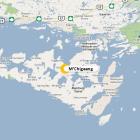2
From Sault Ste. Marie we continue east to the community of M'Chigeeng on Manitoulin Island. Formally known as West Bay First Nation, M'Chigeeng means "village enclosed by stepped cliffs." Centrally located on the Island where Highways 540 and 551 meet. For more information please visit: www.mchigeeng.ca3
M'Chigeeng is home to the Ojibwe Cultural Foundation, who represents 60 First Nation communities, or approx. 15,000 people from Sault Ste. Marie east to North Bay and south to Parry Sound, with the exception of Wikwemikong. Their mandate is to preserve and promote the heritage, customs, and language of the three fires people - Odawa, Patawani, and Ojibwe. The organization has been in existence for 25 years, and celebrated the grand opening of the new facility at M'Chigeeng First Nation on September 3, 1999.5
OJIBWE CULTURAL FOUNDATIONThe Ojibwe Cultural Foundation strives to be the identity center of the Anishnaabe people and remains committed to the revitalization and growth of the language, culture, arts, spirituality and traditions of the Anishnaabe People of the First Nations of the Robinson Huron Treaty area. They dedicate themselves to the expression of Anishnaabe culture in all forms, so their art, language, stories, songs and teachings flourish now and remain strong for generations to come.
The Foundation began in a small trailer in 1974 on the M'Chigeeng First Nation as the dream of a core group of determined Anishnaabe cultural and language activists. Lead and inspired by the late Mary Lou Fox, their founders realized that essential community services and resources were missing in the struggle to maintain the Ojibwe language and cultural heritage of the Ojibwe, Odawa and Pottawatomi Nations.
Over the years the Ojibwe Cultural Foundation brought Anishnaabe together to revitalize efforts to restore their culture and the Ojibwe language. They created much needed learning resources for use in schools and homes, and worked with elders and wisdom keepers to make traditional customs and ceremonies a part of daily lives. They encouraged and helped Anishnaabe visual artists to share their unique vision with the world.
In 1999 the Foundation moved to its current location, an 11,000 square foot facility located in M'Chigeeng on the site of the original trailer. This facility included an elder's room, arts and craft retail outlet, museum, art gallery, healing lodge, classroom and presentation area, AV studio, resource centre, and administration offices. Recent renovations have included the addition of a performance amphitheatre, arts theatre and an artisans market. This has allowed the Foundation to expand its arts, language and heritage programs and grow as an internationally recognized advocate and guardian of Anishnaabe culture.
As part of the continuing effort to maintain Anishnaabe language and traditional knowledge and strengthen traditional customs and practices for all generations the Foundation organizes an Elders/Youth gathering. This annual gathering brings respected Elders and traditional wisdom keepers together with Anishnaabe youth from across the territory.
The 2008 Mkwa-Giizis Maawnijiding Youth & Elder Gathering was held on the M'Chigeeng First Nation and included traditional topics such as: Teachings of the Pipe, Teachings on Anishnaabe uses of Colour, Seven Stages of Life, Sacred Fire Teachings, Water Teachings, and Teachings for Young Men and Young Women. Craft sessions on ash basket making and quillwork were also offered.
7
A large part of the dedication and preservation of the culture of the First Nations is education. The Ojibwe Cultural Foundation has many different programs available for everyone to share, such as cultural workshops that encompass traditional crafts, traditional dance, language tutoring and translation as well as the Anishnaabek history.Every year the Foundation hosts the Anishnaabe Youth Summer Art Camp. The camp is held in various First Nations on Manitoulin Island and the north shore of Lake Huron. The camp gives participants the opportunity to learn from well -known Anishnaabe artists and traditional artisans in a beautiful natural setting. The camp is a blending of outdoor activities such as camping, hiking, canoeing, swimming, fitness exercises, traditional learning and art studies, with plenty of fruits and veggies and campfire food.
Their 2008 camp was particularly engaging for participants who were introduced to print making and tutored in the print making process by master print maker Ahmoo Angeconeb. Accomplished woodlands style artist Mark Seabrook conducted acrylic painting classes. Traditional Elder, Eddie King offered teachings on ancient Anishnaabe petroglyhs and Lenore Keeshig-Tobias provided story-telling sessions. The group was given a studio tour of noted woodlands artist Leland Bell's creative space and attended a performance of The Gift, an original stage play created and performed by the Debajehmujig Theatre group at the Foundation's amphitheatre.
For more information please visit:
www.ojibweculture.ca


